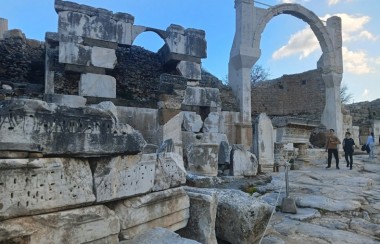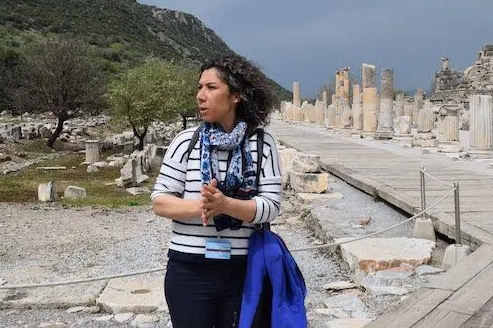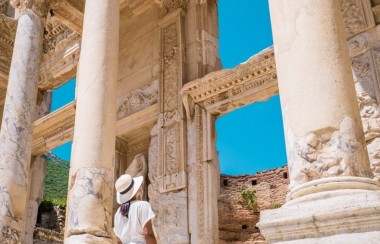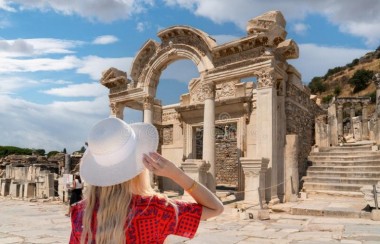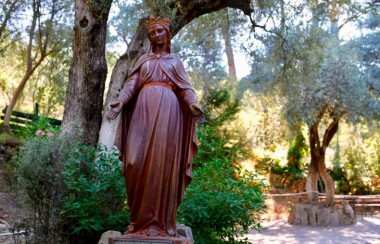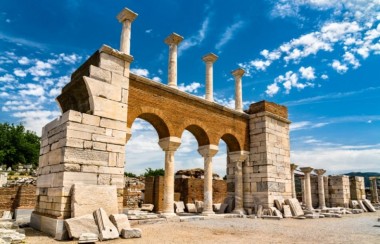Domitian Square is dominated by the Temple of the Imperial Cult and its artificial terrace. This enormous square is bordered from the east by a series of buildings along the so-called Domitian Street. These buildings — the Chalcidium, the Pollio Monument, and the Fountain of Domitian — also demarcate the western side of the State Agora.
The first structure among this rather crowded for the eye assembly of buildings along Domitian Street, walking from the north, is the Chalcidium. This projecting bulk of massive ashlar blocks is hard to miss. Its name means a portico or a hall that formed an annexe to an ancient Roman basilica. In Ephesus, it played the function of a substructure supporting the western end of the Basilica Stoa of the State Agora, and it was probably added in the times of Emperor Nero. The three chambers of the Chalcidium projected out to the Domitian Square through the doorways opening directly to the square.
Just next to the Chalcidium stands the monument known as the Pollio Monument. It was erected in the form of a memorial tomb by the stepson of Gaius Sextilius Pollio in the area designated to honour his valuable donations to Ephesus. For instance, Pollio sponsored the water conveyance system that brought water to Ephesus via the Pollio Aqueduct. Moreover, he also paid for the Basilica Stoa of the State Agora. The dimensions of the Pollio Monument are 8 to 6.5 meters, and its current height is 6.4 meters.
The Pollio Monument was later expanded when the large semi-domed apsidal construction of the Fountain of Domitian was added to its southern part in 92/93 CE. Water brought by the aqueducts to the city was distributed from this fountain by a branching system of baked clay pipes. The structure has been recently restored with the effect clearly visible in 2019 as the previously used grey concrete fillings are now replaced with the ones that blend in more with the original elements.
The most exciting find from this fountain was a group of statues that adorned it. These statues were not made, especially for this monument, but they were brought here from other locations. The most spectacular of them is the group representing the familiar theme of the blinding of Cyclops by Odysseus and his companions, frequently referred to as the Polyphemus Group. The group dates back to the 1st century BCE. Other sculptures represent the river gods — Marnas and Klaseas — that had been placed in the northern and southern niches while the statue of Zeus stood in the central, western niche. The Polyphemus Group and other statues are now on display in the Ephesus Museum in Selçuk.
The characteristic round base decorated with garlands carried by bulls’ heads stands in the centre of the Domitian Square. It was moved into this location from some other part of the city, possibly in the middle of the 4th century. This could be a sacrificial altar and its decorations symbolize fertility and abundance.
Flanked by taverns and shops, the Domitian Street climbed up in the southern direction, following the eastern side of the Temple of the Imperial Cult's substructure. It is not certain if this substructure, the so-called cryptoporticus, was accessible for passers-by. However, its well-lit and ventilated corridors would have provided ideal space for storage. Quite recently, these rooms were used by the archaeologists to house the Inscription Museum, but it is now permanently closed.
Related Shore Excursions
Explore Ephesus History with our Shore Excursions .
Ancient Ephesus
Ephesus comprises successive Hellenistic and Roman settlements founded on new locations, which follo...
Discover Majestic Ephesus
Majestic Ephesus takes you on an unforgettable journey through history; etched on minds as the...
House of Virgin Mary, Ancient City of Ephesus, Basilica of St.John
Ephesus played an important role in the spread of Christianity. Ephesus is&...
Biblical Ephesus
Ephesus played an important role in the spread of Christianity. Ephesus is&...

